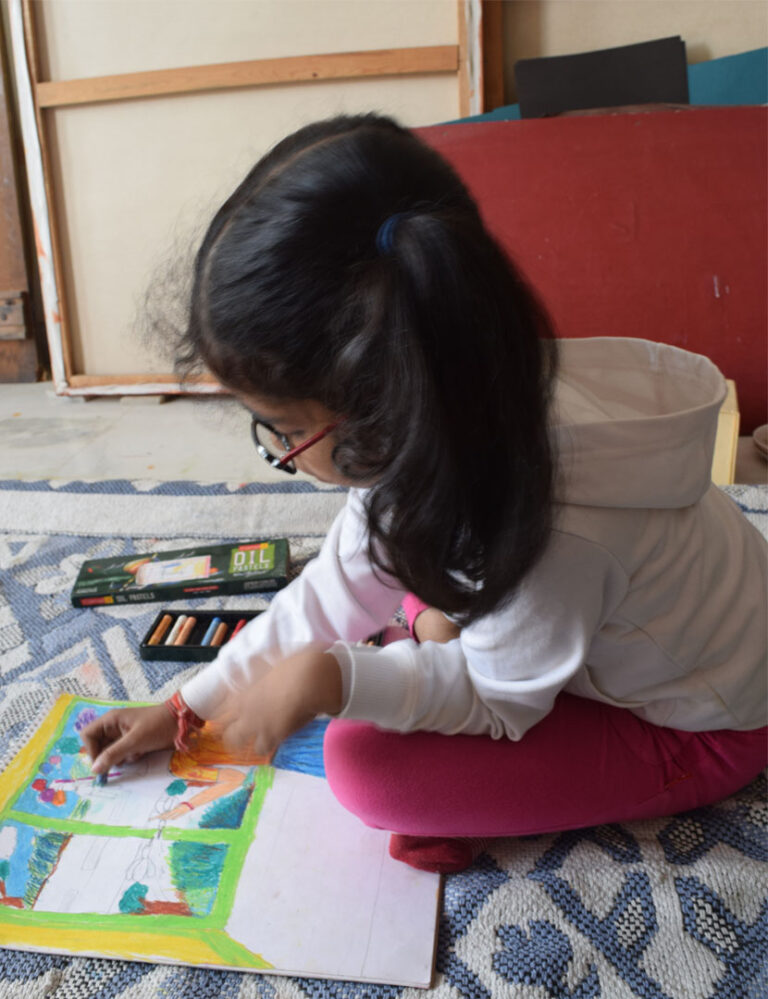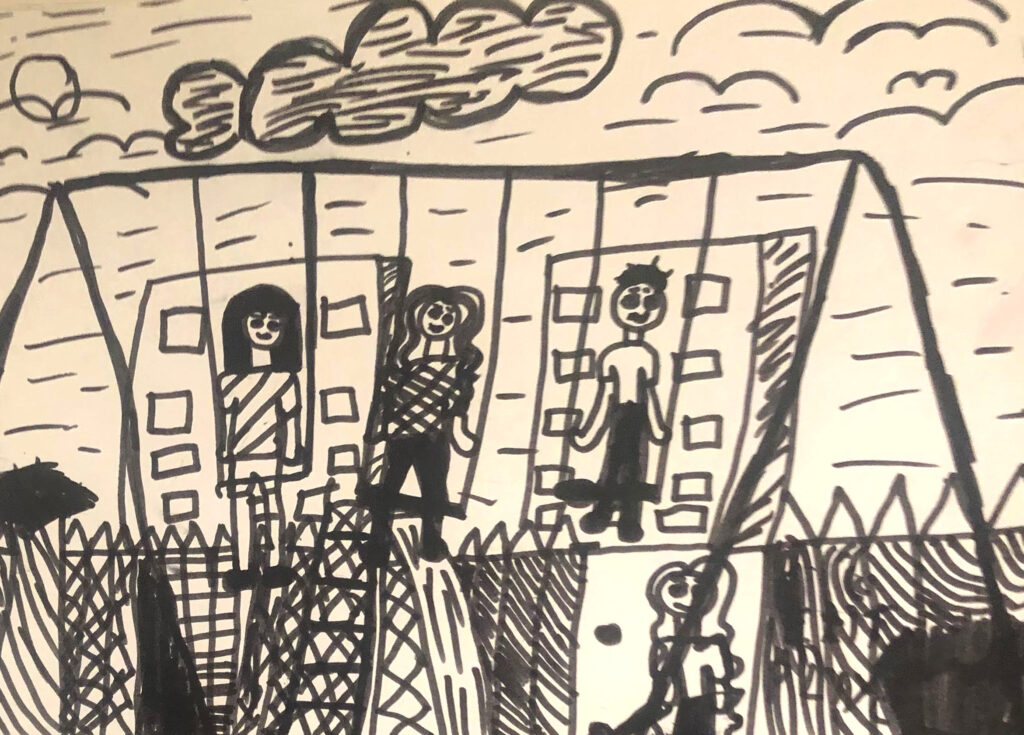Encountering the blank space…

Of late I have been thinking a lot about the ways I engage with young learners in school in the art class or in a workshop. These classes or workshops are mainly in schools, hobby classes and workshops organized by museums and NGOs. Engaging through art is a dynamic process. Here I am reflecting on the possibilities in distinct practices I have taken up or practices of my colleagues which I have found relatable while working with children using art as a medium.
In the year 2003, I joined a school in Delhi as an art teacher. The art period was forty to forty-five minutes long. With around forty or a few more children in the class, distributing the art material to them and then doing the exercise meant not even a minute per child. Besides that, there was hardly any art curriculum and a very basic set of guidelines by the board of education.
Not having any curriculum or well laid out guidelines was both a boon and a bane. Initially, I started working with different topics related to their immediate surroundings, festivals, seasons and so on. The sheet had to be filled with their imagination around the given topic. As the art teacher, my role was to activate their imagination around the topic. I tried different ways such as storytelling, bringing in some props or taking them out of the class to show some related things. It may sound easy but doing it is actually quite difficult. The energy and the mindfulness required are immense. 2003 was still too early for a projector and a computer in every class room. Besides the initial information, ideas and instructions shared with the entire class, it involved several rounds of responding to each child’s individual imagination and drawing skills. All this had to be done in a fun manner. Otherwise, children and their parents would lose interest especially in a subject where there are no marks. Very soon I realized that the children liked my class and I enjoyed working with them. What started bothering me was the monotony of this topic giving exercise.

I wanted to break this monotony. An instant solution was to take the children outdoors and draw trees, foliage. After a few outdoors in a year, the monotony returned. I had to go back to the topic giving module. I tried making it enjoyable by incorporating different medium & techniques but wanted something more to happen in my interaction with young children. Not sure whether it existed then but I was not aware of ready to use modules, lesson plans and demo videos as they are widespread now a days. My next aid was few art and craft books in the library. Most of these books were not made for the Indian scenario. So, every time I picked up an exercise from these books, I had to make it specific to my environment and according to the material available here. Gradually, I started designing my own exercises. Fortunately, most of it was well received by the learners, the parent group and even to a great extent by the school authorities. Thankfully, a range of ready to use modules weren’t there. Though over the years I have designed so many exercises and modules for art teachers, I honestly feel every teacher should design their own activities or exercises. Even if they are using a module designed by someone else, they should reframe it specific to what they want to do in their classrooms, keeping in mind the specific learning requirements in their classrooms. However, now a day we have everything ready to use. The activity, related references, the story of the artist, even formation of the drawing – everything is already put together. As a result, often all the twenty five or thirty learners in the class end up drawing the same thing. For me thirty to forty drawings from a group of children looking similar is extremely disheartening. Now days, to work on everyday topics or scenes as a method is usually considered obsolete. Every art exercise has to become an elaborate module.
During the pandemic, I attended several webinars on art education. In one of those, a performance artist who works as an art teacher in school briefly mentioned about different methods she uses in her art classes and one of those is giving topics like any festival or a market scene. I instantly recollected mine. Children’s imagination grows beautifully through the visual interpretation of interaction around different topics. Their observation skills and memory are also actively engaged. However, there is a shortcoming in this method. Very early in their learning, children realize who can visually express and who can’t. This can very easily de-motivate a young child to engage with art. Very few art teachers are able to break this and appreciate a child’s work for its strengths and critique it towards exploring more possibilities. With the obsession for photograph like finishing in drawing or painting in the Indian scenario, very early a learner becomes overtly judgmental about their creative expression. Another shortcoming of this method is the lack of challenge or anticipating the unknown for the art teacher. Teaching art ends up becoming a routine with no stimulus and in most cases the art teacher goes with no prior preparation or even a tentative plan.
Over the years I have tried out different approaches in my sessions. Sometimes I have introduced day to day topics, sometimes observational drawings and sometimes examples from art history like modern art movements, works of masters both Indian and from outside India and even contemporary art practices to young children. Some worked well while many didn’t and had to be reframed. I definitely enjoy bringing examples of artists, their work or a particular art movement. This adds more diversity to the art class through stories of different people, places and time frames. However, I am skeptical of working only through these throughout the academic year. All the time if a child is shown examples of art or artists and exercises are centered on that, rarely does the child gets to encounter the blank or empty space in a sheet. There is already a precedent to follow. Within the stipulated time in a school curriculum, it is almost impossible for a young child to overcome the awe of a master’s work. Most of the times, the art teacher is not able to simplify the different aspects of the artist’s work or the art movement shown. Many art teachers are not able to design the exercise where the child makes connection between what is shown from art history and things they already know. For example, if Cubism as an art movement is taken up then simply making the children do Cubist looking drawings is not an effective method. Rather posing the challenge of how to show a form from different perspective on the same pictorial space can be more challenging. For this, more than the learner the art teacher has to be prepared about the artist or art movement taken up and that effort is usually quite rare. Rather, it is missing.
While saying this, I must admit there are a range of related concerns such as – what becomes of young art graduates as art teachers in schools? Who they are? What is this ‘art teacher figure’ like especially in a scenario where there is barely any engagement with art education in our degree and PG courses? Who is this practitioner who engages with generations of young learners but has no presence in the contemporary art scenario? There are a range of such concerns about which I will write a separate post but surely in a scenario like this there is hardly any space for extended inquiry and meaningful engagement and inquiry.
Different approach has different possibilities. The main question then is to what extents are we pushing our own limits and exploring a particular method or approach. Working with only one kind of approach will limit both the educator and the learner. It is very surprising and disheartening to see how majority of art teachers in school are happy to live this monotony in their class rooms for years. However, when I heard the fellow educator in the webinar, I felt the need to not completely abandon working with everyday or commonplace topics. Surely, a few ‘me and my pet’, ‘my playground’ or ‘a market scene’ will not be all that boring or bad for the children.
Credit: I thank all my young learners, their parents, different schools and other organizations I have worked with for letting me document and use the children’s work to illustrate my understanding around art education practices.